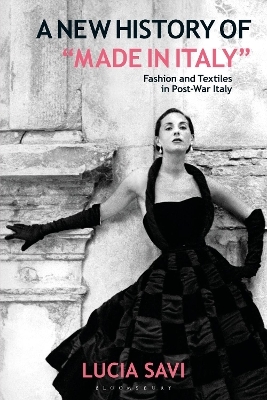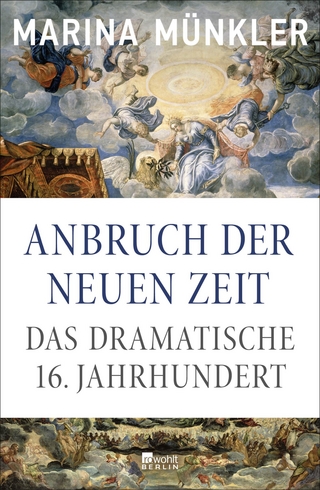
A New History of "Made in Italy"
Bloomsbury Visual Arts (Verlag)
978-1-350-24779-6 (ISBN)
In the first book to examine the role played by textile manufacturing in the development of fashion in Italy, A New History of ‘Made in Italy’ investigates Italy’s transition from a country of dressmakers, tailors and small-scale couturiers in the early post-Second World War period to a major producer of ready-to-wear fashion in the 1980s. It takes the reader from Italy’s first internationally attended fashion show in 1951 to Time magazine’s Giorgio Armani April 1982 cover story, which signalled the fashion designer’s international arrival, and Milan’s presence as the capital of ready-to-wear.
Chapters focus on the material substance of Italian fashion – textile – looking at questions including the importance of manufacturing quality, design innovation, composition, production techniques, commerce and the role of textile on the country’s overall fashion system. Through these, Lucia Savi brings to light the importance of synthetic fibres, previously little-known players, such as the carnettisti (a type of textile wholesalers) as well as re-investigating well-known couturiers and designers such as Simonetta, Gianfranco Ferré and Gianni Versace.
By looking at how things are made, by whom, and where, this book seeks to unpack the ‘Made in Italy’ label through a focus on making. Informed by extensive archival materials retrieved from a wide range of sources, it brings together the often-separated disciplines of fashion, textile and design history.
Lucia Savi is a curator at the Design Museum, London. In 2021 she curated the V&A exhibition Bags: Inside Out and authored its accompanying publication. Dr Savi has a PhD from Kingston University, UK, on Italian fashion and textiles, and has contributed to fashion and design exhibitions and their catalogues including The Glamour of Italian Fashion 1945–2014 (V&A, 2014) and Beyond Bloomsbury: Design of the Omega Workshops 1913-1919 (Courtauld, 2009).
List of Figures
Acknowledgments
Glossary
Introduction
Locating Italian Fashion
Made in Italy
Researching ‘Made in Italy’
Primary Research Sources
The Inside-Out Method
Research Parameters
Chapter Structure
1. Fibers and the Making of Italian Textiles in the Post-War Period
Introduction
Italy between Tradition and Modernity
Between Couturiers and Manufacturers
From Paris to the USA’s influence
The Fascist Period and the 1930s
Fibers and Politics
Italian Fashion’s Materiality
Natural, Artificial and Synthetic Fibers
Silk, artificial and synthetic fibers
SNIA Viscosa and Fibers Promotion
The Legitimization of New Fibers
2. The American Export Market and its Influence on Italian design
Introduction
Textiles Make Fashion: Italy at Work and Sala Bianca
Italian Fashion in Italy at Work
Italian Textiles in Italy at Work
Sala Bianca
Italy and the USA: Export and Domestic Market
The Value of Hand Made and Machine Made in Italy and USA
Boutique Fashion as Proto Italian Ready-to-Wear
The Mechanisms of Copies– Italy and the USA between ‘Made in Italy’ and Export
Made in Italy and Export
The Transatlantic Commerce of Italian Couture: Simonetta Case Study
Ready-to-Wear versus Couture
The Value of Copies
3. The 1960s, a Decade of Metamorphosis in Italian Fashion
Introduction
Treaty of Rome and Export
The Camera Nazionale della Moda Italiana (CNMI) and the Promotion of High Fashion
New Ways of Production, with New Products and New Ways of Consumption
Industry and Alta Moda
Boutique of Ready-to-Wear
4. Fashion meets Industry: The Role of Carnettisti in Domestic and International Markets
Carnettisti in Italy
The Assortitori Tessuti Novità (Sorter of New Textiles)
Distribution of Textiles in the 1960s
Carnettisti in CNMI: Towards a Codified Role and Crisis
5. Milan and the Stilisti
Introduction
Rise of Milan
Distretti Industriali (Industrial Districts)
The Stilista, the Link between Textile and Fashion Production
Stilista and Industrial Production
Transition from Carnettista to Stilista
6. Designing for Mass-Production
Designing Fashion
Literature Review for Fashion Working Drawings
Fashion Working Drawing Decoded
Paper, Type of Drawing and Inscriptions
Style and Aesthetics
Textiles
Gianfranco Ferré: a Case Study
Conclusion
Inside Fashion: the Role of Materials and Production
Fibers and materials
Internationalization
Industrialization
Bibliography
Index
| Erscheinungsdatum | 05.10.2024 |
|---|---|
| Zusatzinfo | 34 bw and colour illus |
| Verlagsort | London |
| Sprache | englisch |
| Maße | 156 x 234 mm |
| Themenwelt | Kunst / Musik / Theater ► Design / Innenarchitektur / Mode |
| Kunst / Musik / Theater ► Kunstgeschichte / Kunststile | |
| Geschichte ► Allgemeine Geschichte ► Neuzeit (bis 1918) | |
| Geisteswissenschaften ► Geschichte ► Regional- / Ländergeschichte | |
| Sozialwissenschaften | |
| ISBN-10 | 1-350-24779-0 / 1350247790 |
| ISBN-13 | 978-1-350-24779-6 / 9781350247796 |
| Zustand | Neuware |
| Informationen gemäß Produktsicherheitsverordnung (GPSR) | |
| Haben Sie eine Frage zum Produkt? |
aus dem Bereich


